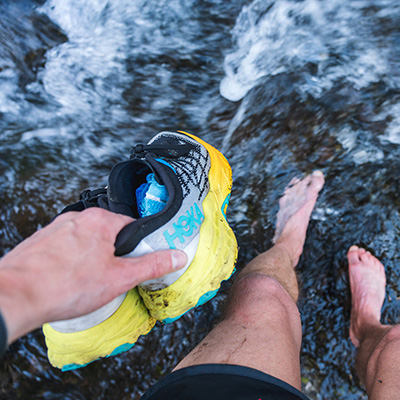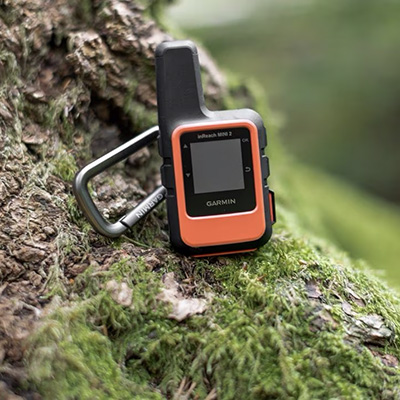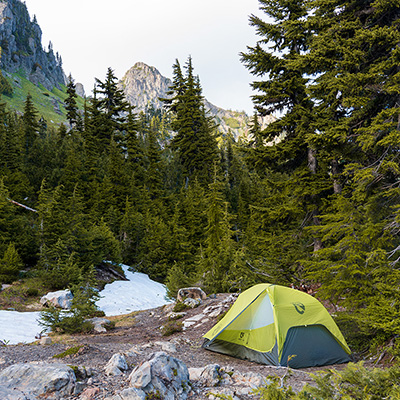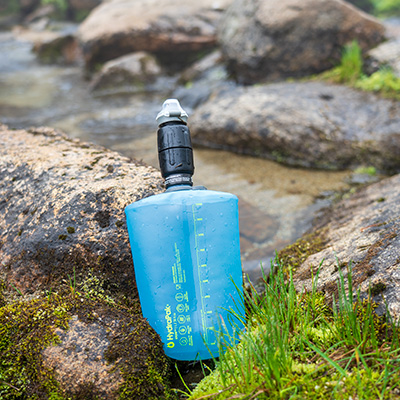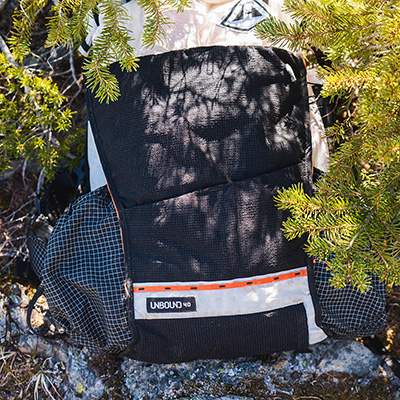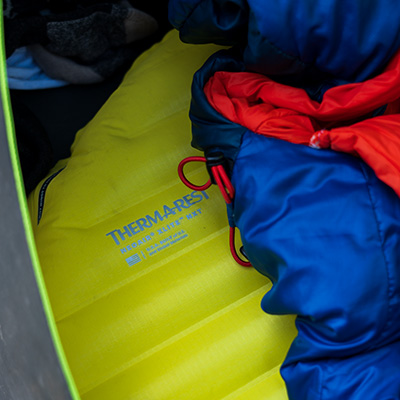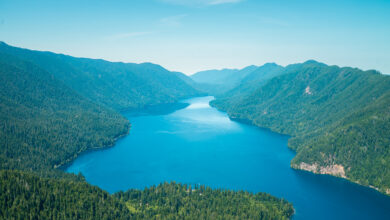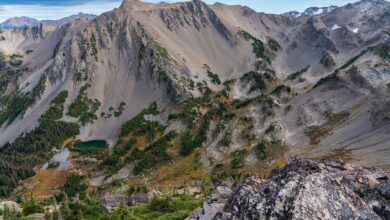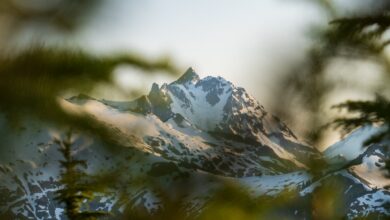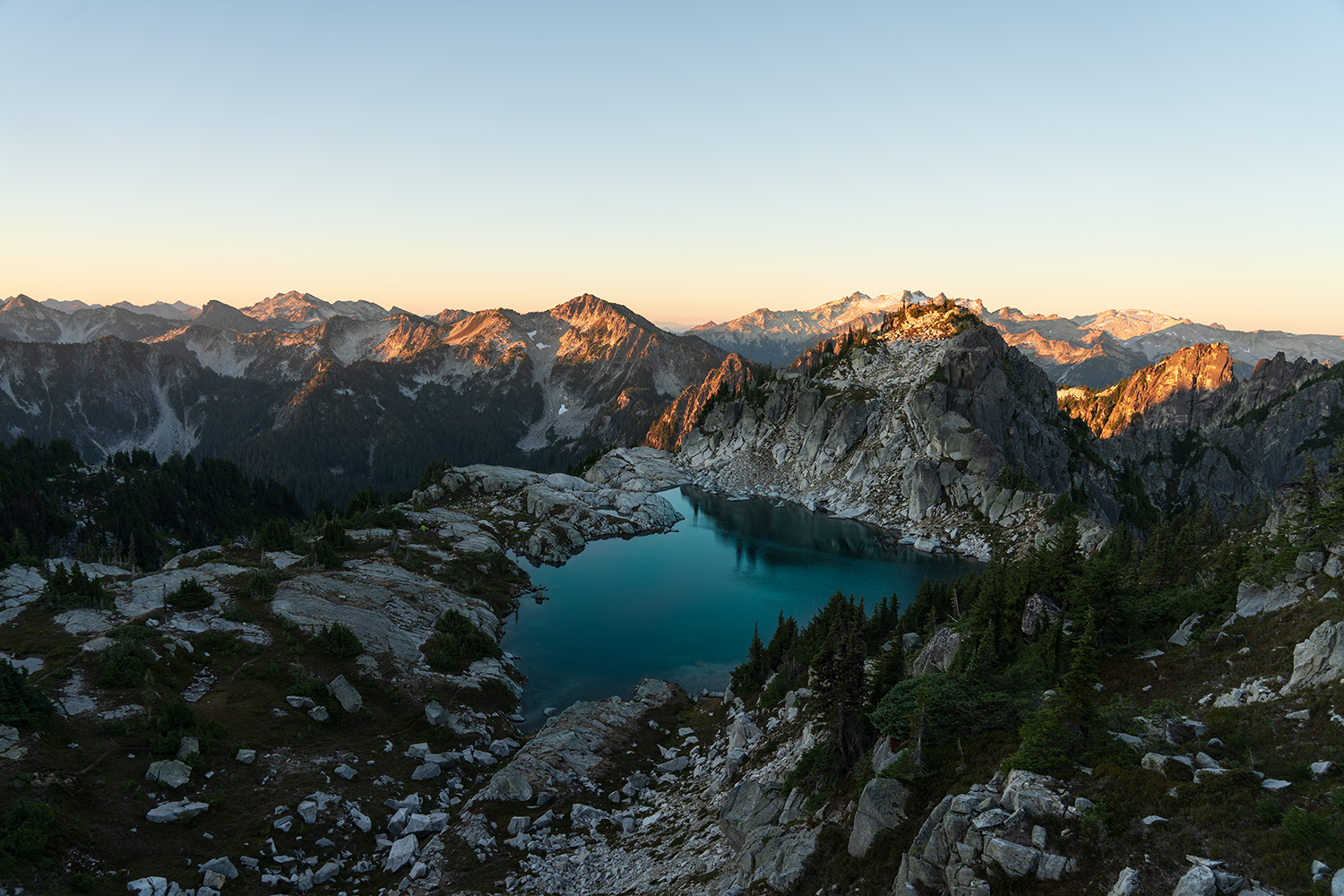
- Total Distance: 13.5 miles
- Elevation Gain: 4,167 feet
- Difficulty Level: Hard
- Passes Required: Northwest Forest Pass
- Camping Permits: Self-Issued Permits
If you’re seeking a challenging yet rewarding hike in the Alpine Lakes Wilderness that offers both solitude and stunning views, Thunder Mountain Lakes is a must-visit. Unlike the more popular and often crowded trails to Colchuck or Jade Lake, this lesser-known route provides a peaceful escape into the pristine beauty of the Alpine Lakes Wilderness. The trail is demanding, but the breathtaking vistas at Thunder Mountain Lakes and the serene alpine environment make every step worth it. This hike is perfect for those looking to escape the crowds and immerse themselves in a true alpine backpacking experience.
Getting to the Trailhead
The trailhead for Thunder Mountain Lakes is accessed via Forest Road 6095 off Stevens Pass Highway, leading to the Tunnel Creek Trailhead. The forest road is about 1 mile long and riddled with potholes; while a high-clearance vehicle is recommended, a sedan can make it with cautious driving. Be aware that there are no services at the trailhead—no toilets or other amenities—so come prepared. Parking is very limited here so arrive early if you want a decent spot.
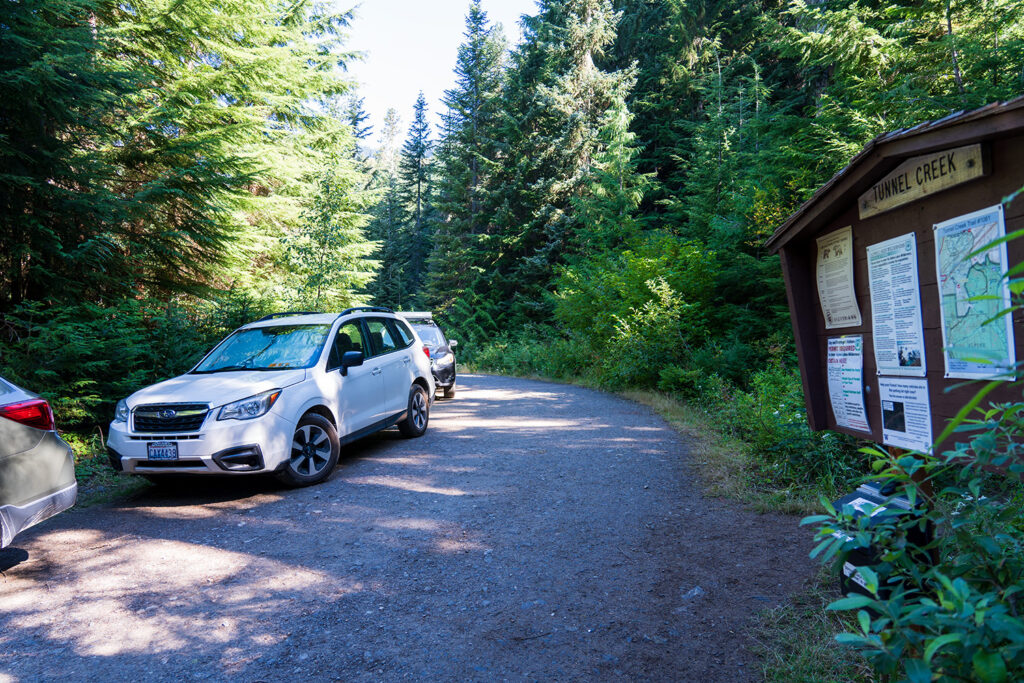
The Best Time to Hike Thunder Mountain Lakes?
The best time to hike Thunder Mountain Lakes is typically from late June through early October, when the snow has melted and the trails are clear. Forest Road 6095, which leads to the trailhead, is usually snow-covered for much of the year, making the trail inaccessible outside of this window.
Weather data not available.

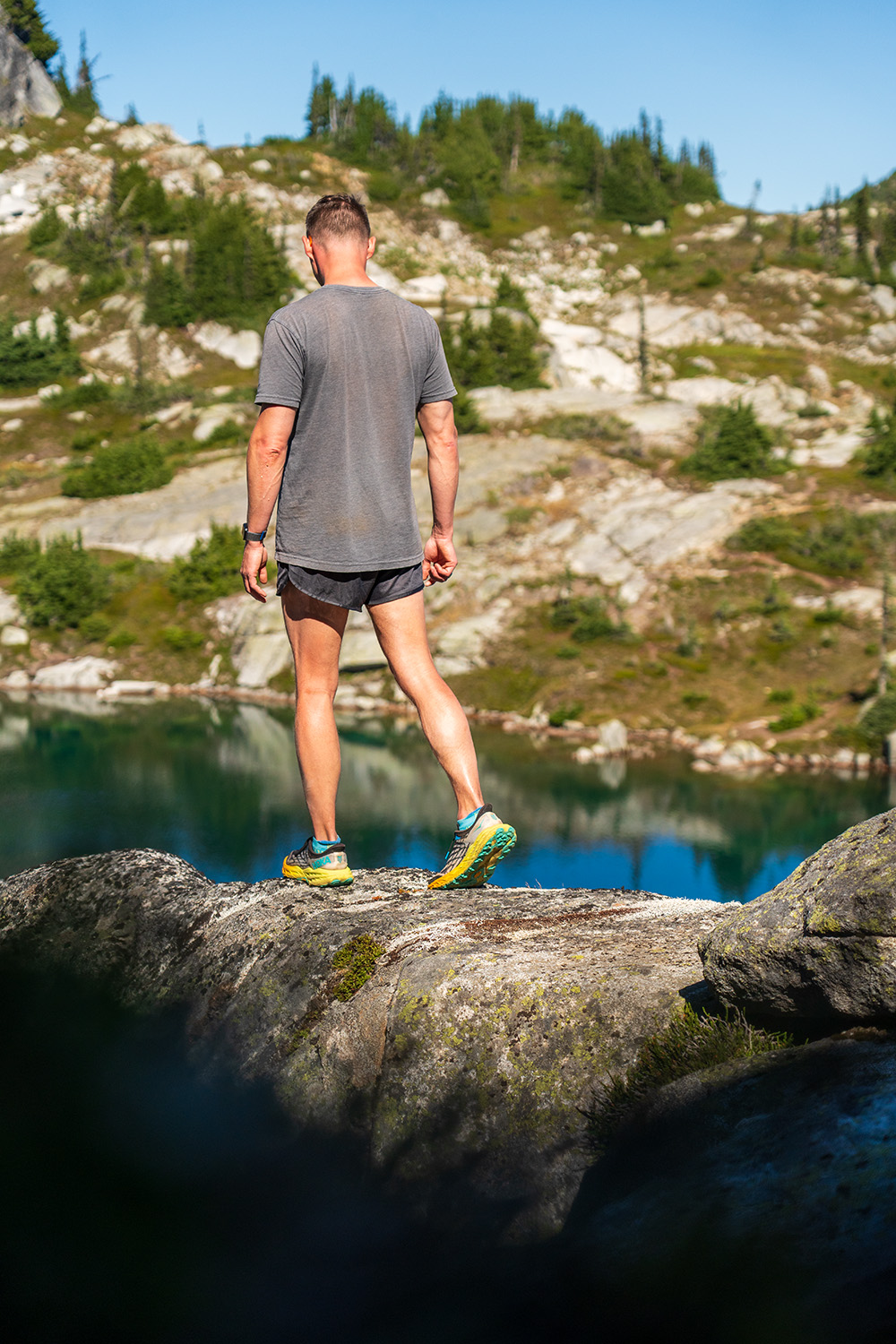
Permit Information for Thunder Mountain Lakes Trail
Before you hit the trail to Thunder Mountain Lakes, you’ll need to grab a free self-issue permit for the Alpine Lakes Wilderness. Permits are provided at the trailhead. Just fill out the card, drop the bottom half in the box provided, and attach the other half to your backpack. It’s a quick and simple process, and it’s required year-round to help protect and manage this beautiful wilderness area.
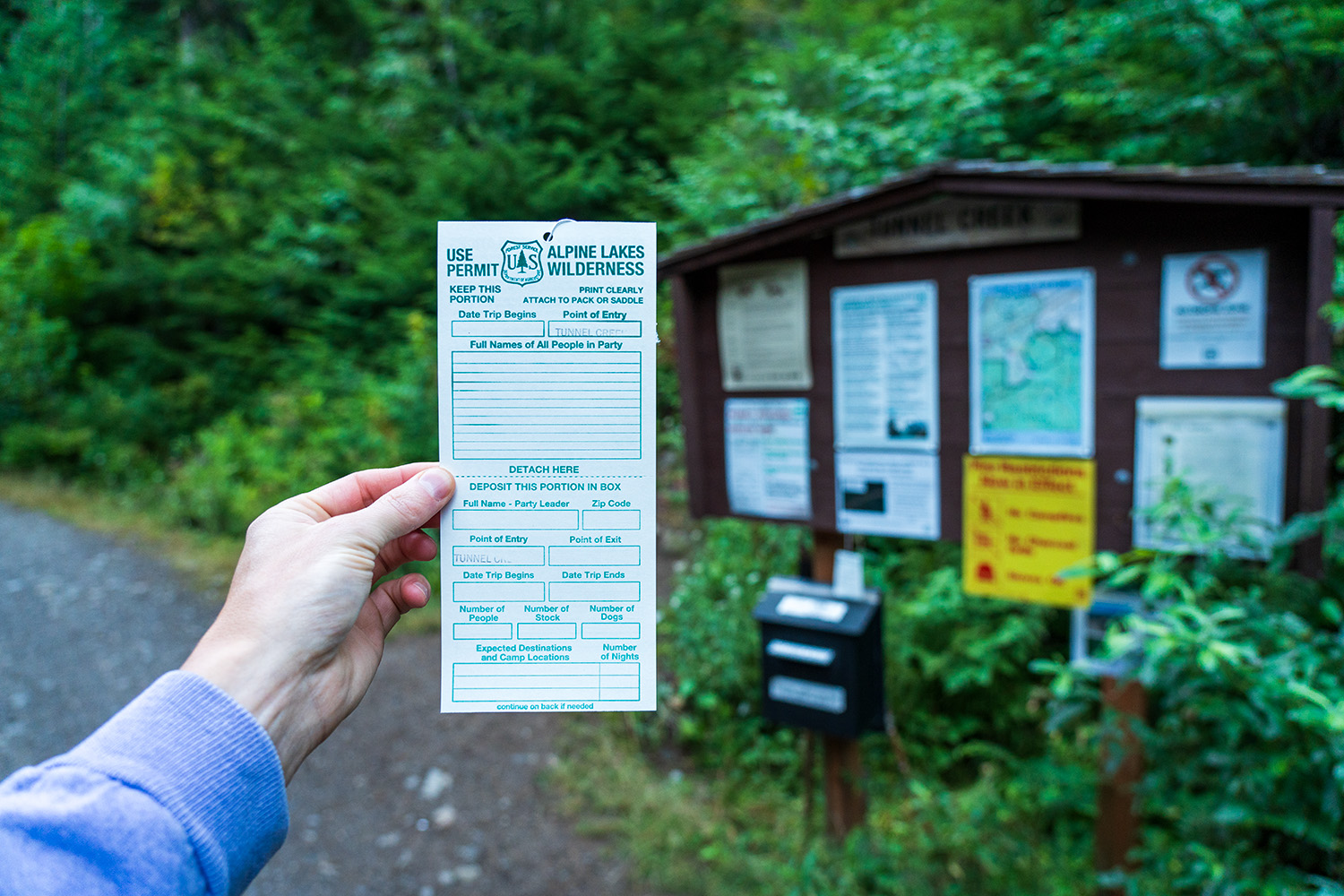
Day Hike or Backpack? Choosing the Best Way to Experience Thunder Mountain Lakes
Since this trail isn’t too long, you can choose to day hike or backpack it—both are great options. As a day hike, it’s a full-day adventure, with about 8 hours of hiking plus extra time to enjoy the lake and scenery. However, to fully experience the area, I recommend backpacking. An overnight stay allows you to relax, explore, swim, and soak in the stunning sunset, sunrise, and night sky. For me, the chance to unwind and connect with the landscape made backpacking the clear choice over a day hike.
Breaking Down the Thunder Mountain Lakes Trail
Trailhead to Hope Lake
The hike begins at the Tunnel Creek Trailhead and immediately challenges you with a steep elevation gain. Over the next 1.5 miles to Hope Lake, you’ll climb nearly 1,200 feet. The initial ascent offers expansive mountain views to your right, with wildflowers lining the trail. As you progress, the trail flattens out slightly, transitioning between dense forest and open meadows. You’ll cross several small streams on well-placed footbridges. This section of the trail is well-maintained but remains steadily uphill, providing a solid cardio workout as you make your way toward Hope Lake. Early in the morning, the trail is shaded and cool, with the sun still hidden behind the mountains.
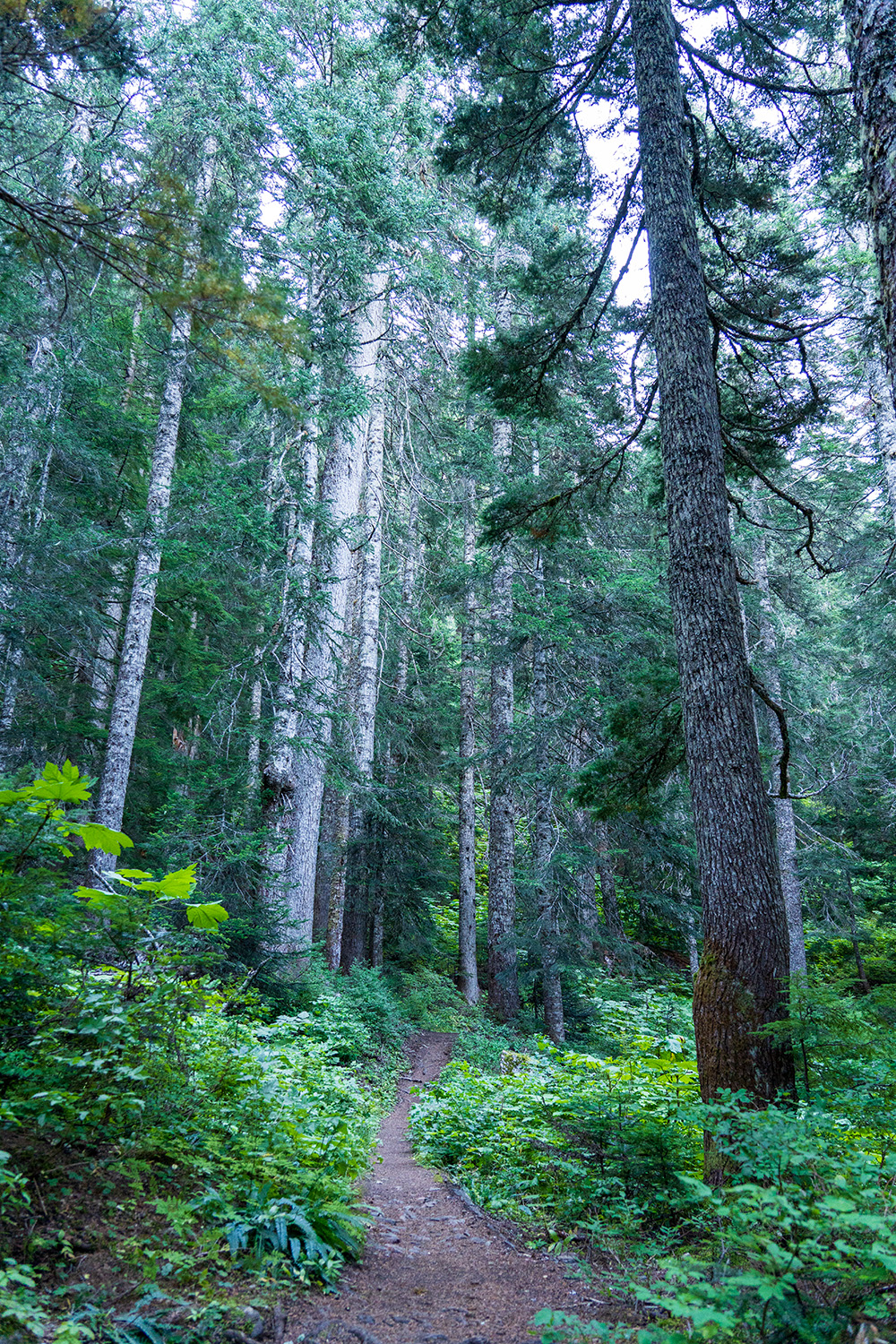
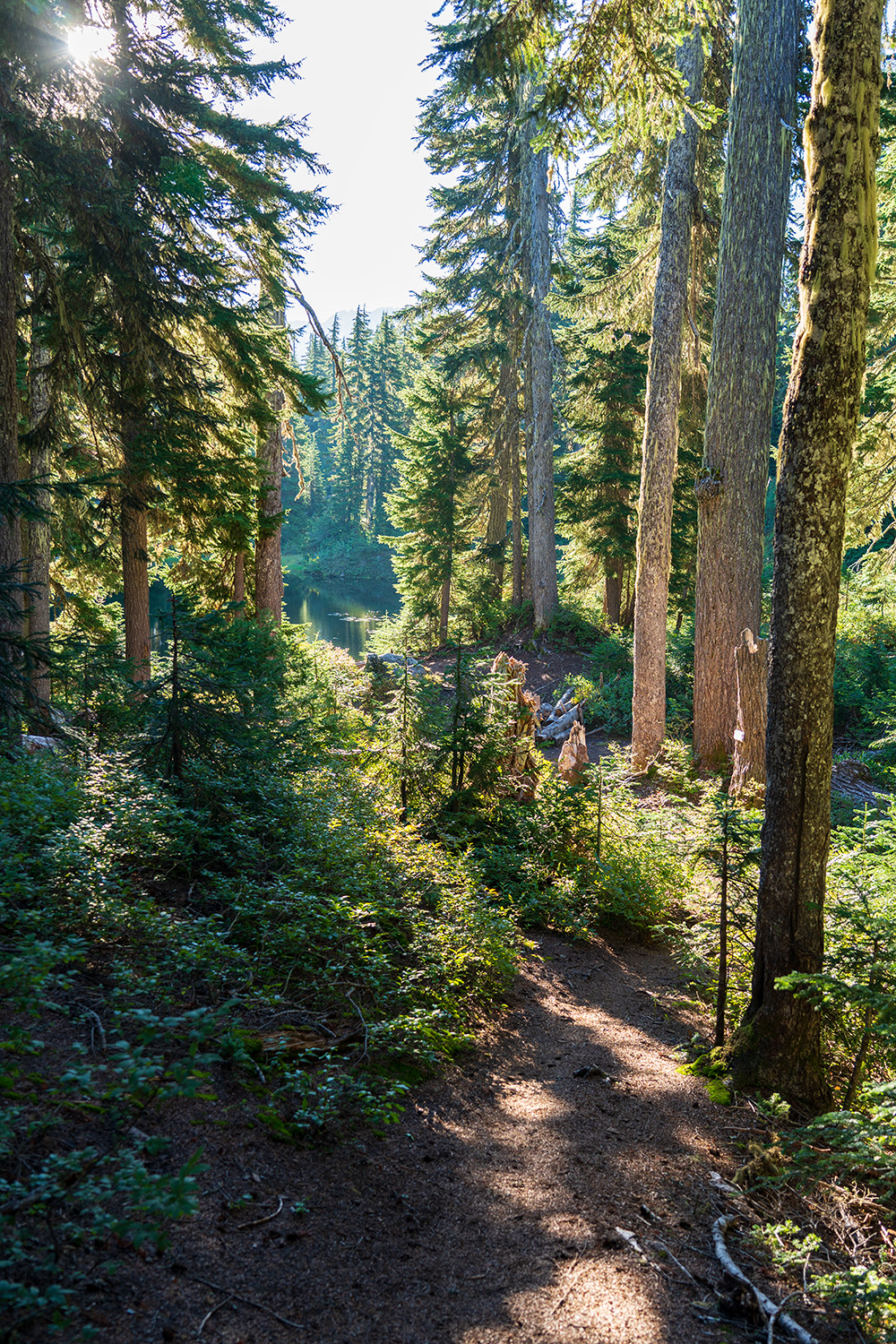
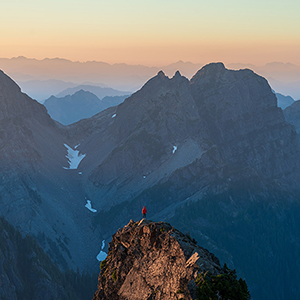
Subscribe to hikewithkurt.com
Get notified when I post new detailed hiking guides and join me on upcoming hikes.

Get notified when I post new detailed hiking guides and join me on upcoming hikes.
Hope Lake to Trap Lake
After reaching Hope Lake, a serene spot with a few lakeside campsites, the trail merges with the Pacific Crest Trail (PCT). From here, the trail winds through blueberry thickets—often picked clean by bears—before dipping back into the forest. Switchbacks dominate this section, leading you through a mix of open meadows and forested areas. The meadows are sprinkled with wildflowers and shrubs, offering occasional glimpses of the surrounding peaks, including the striking granite ridgeline of Lake Lillian Point. A brief downhill stretch provides a welcome respite from the uphill grind. As you near Trap Lake, the trail begins to hug the ridgeline, offering stunning views of the meadows below. This 3-mile stretch gains about 1,000 feet of elevation, making it a bit more manageable compared to the initial climb up to Hope Lake.
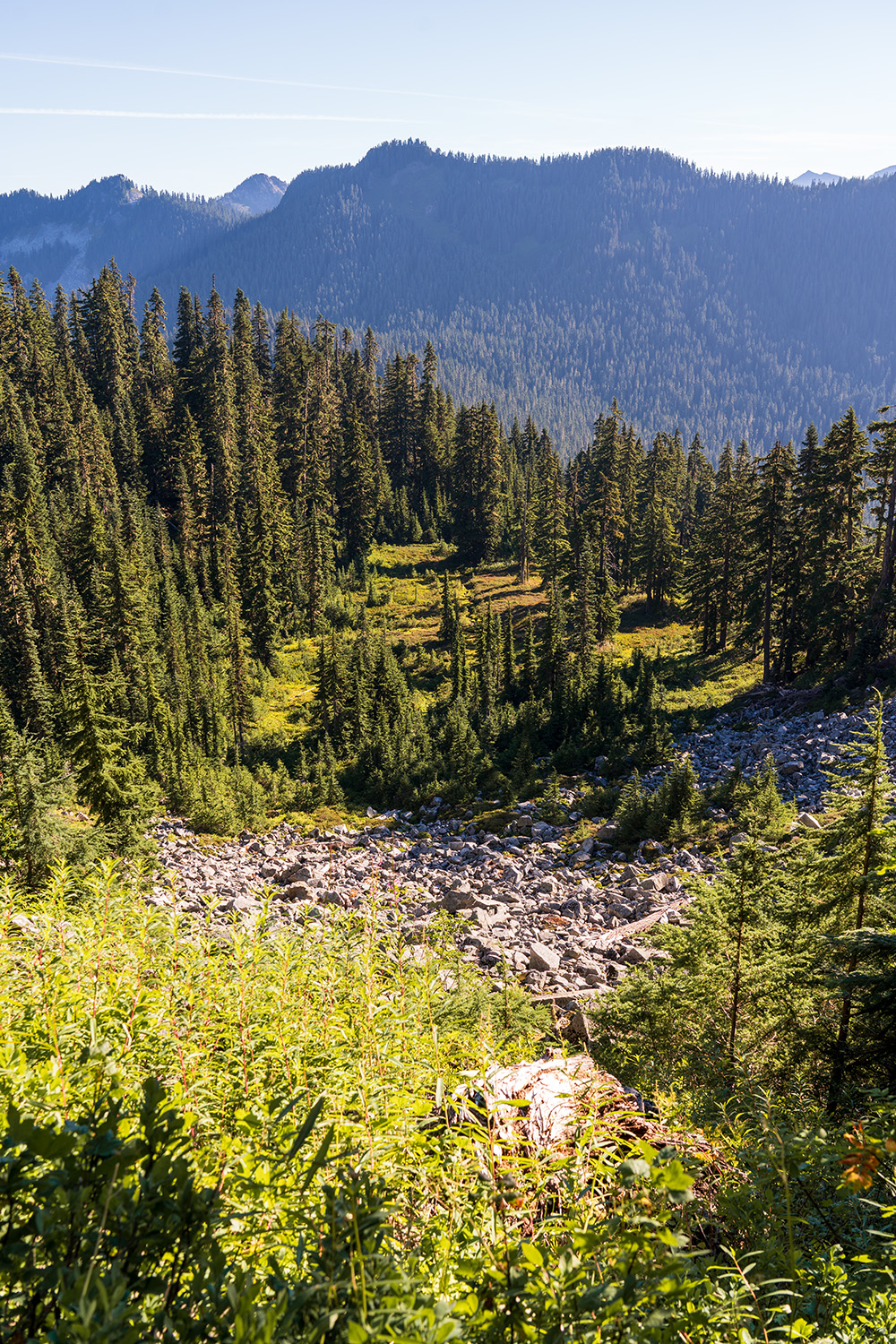
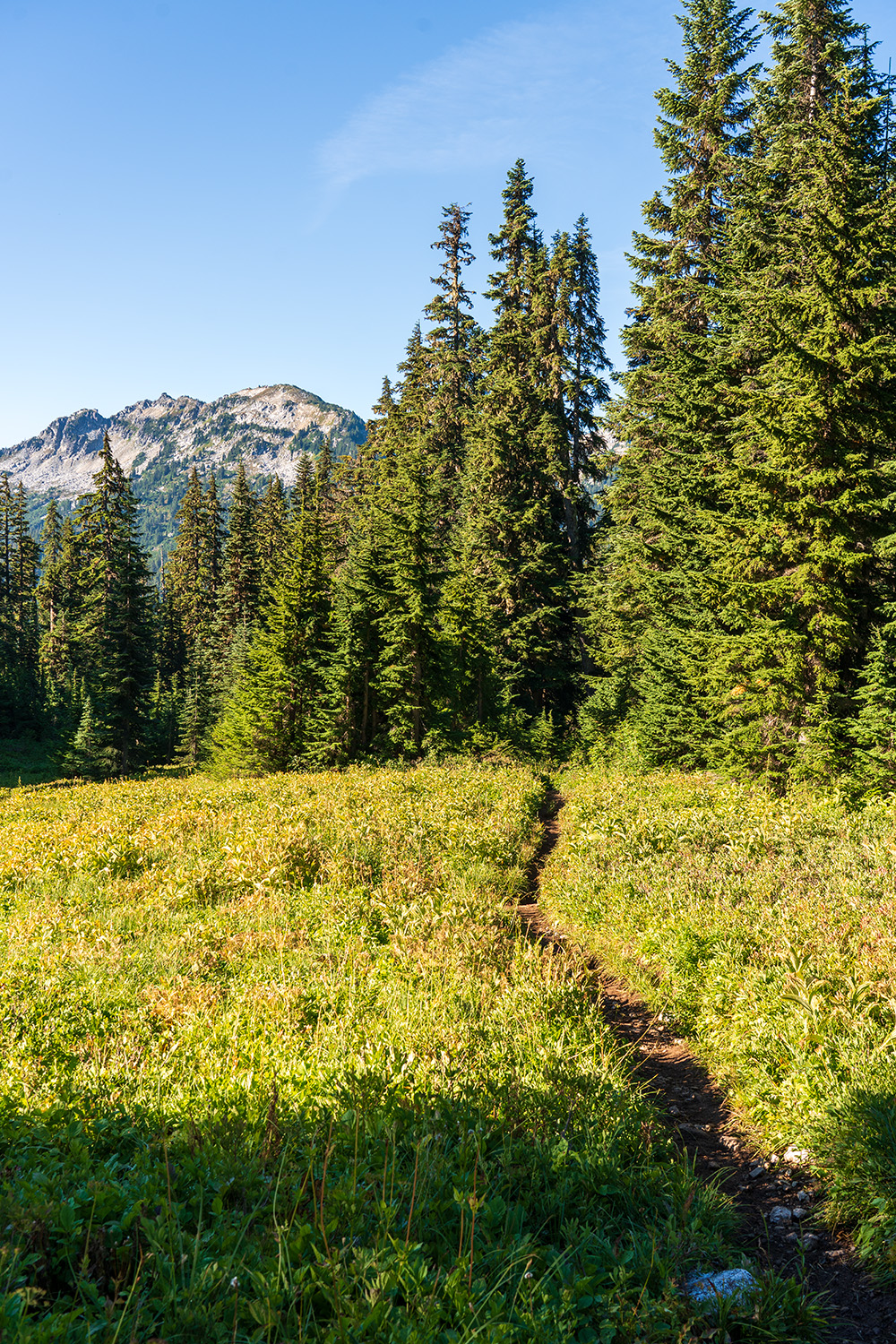
Trap Lake to Trap Pass
Leaving Trap Lake, the trail resumes its uphill climb, weaving through a series of switchbacks. You’ll traverse open meadows filled with heather and blueberry bushes before entering a rocky, boulder-strewn landscape. The trail flattens out briefly, offering a short reprieve for your legs before ascending once more. In this rugged terrain, you’ll likely hear the distinctive squeaks of pikas, adding a lively touch to the otherwise quiet wilderness. As you near Trap Pass, the landscape opens up, revealing expansive views of distant mountain ranges, particularly the rugged silhouette of Thor Peak. At 5.1 miles, Trap Pass is an ideal spot to rest, enjoy a snack or lunch, and soak in the breathtaking scenery.
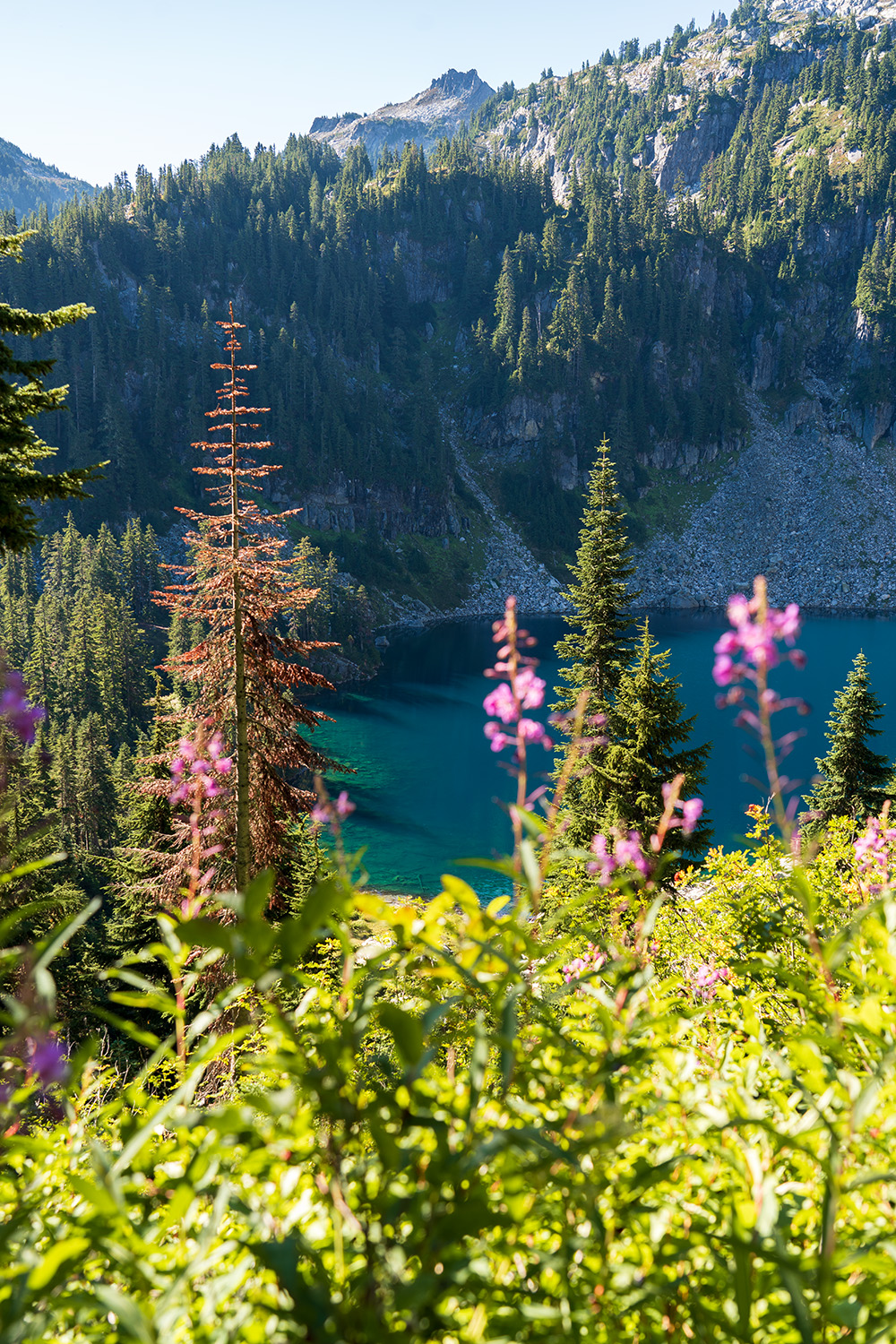
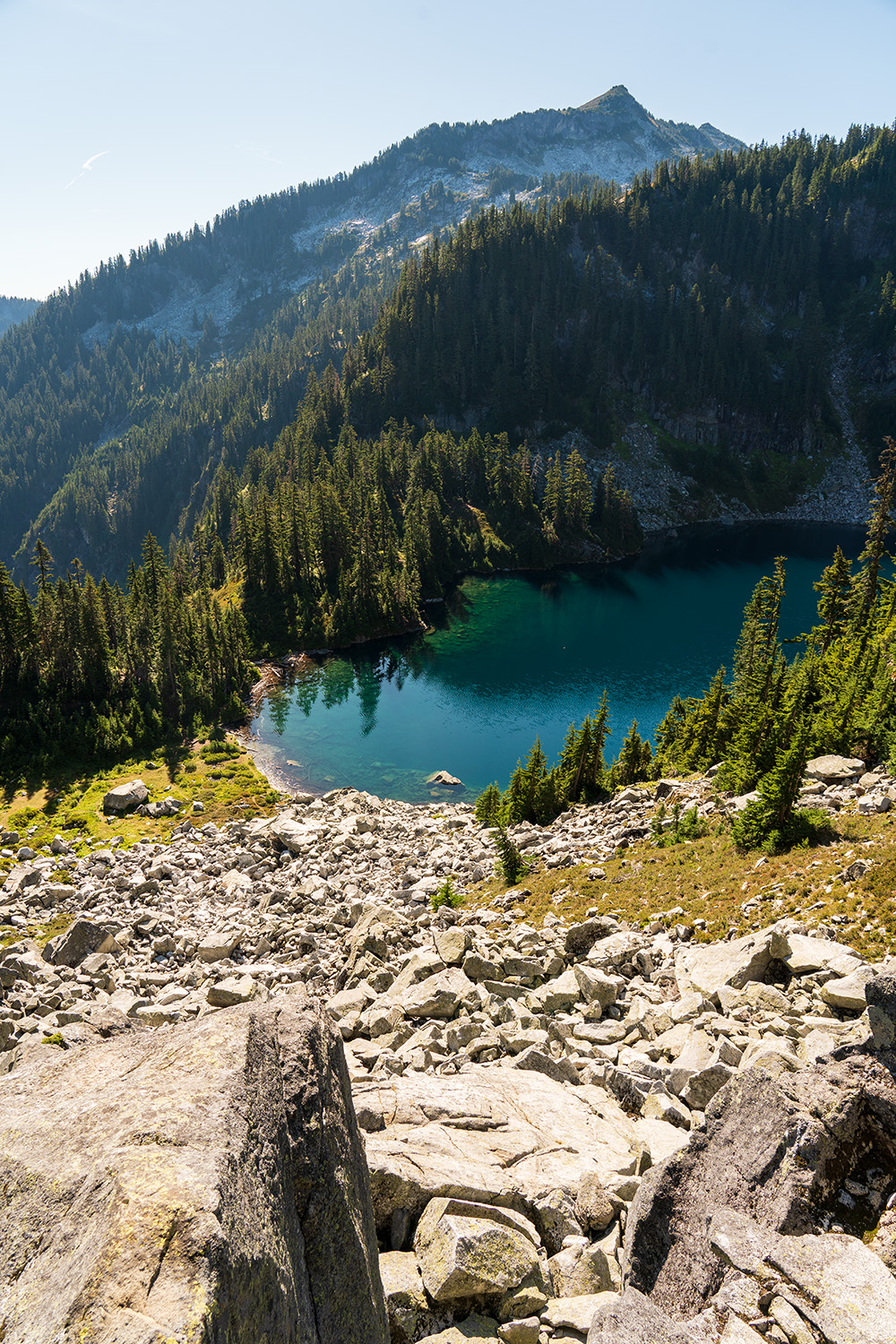

Trap Pass to Thunder Mountain Lakes
From Trap Pass, veer left to avoid the PCT and follow the less-defined herd path that leads toward Thunder Mountain Lakes. The trail becomes increasingly rugged and harder to follow as it winds through expansive boulder fields. Cairns offer some guidance, but you’ll need to stay vigilant to stay on track. In the early summer months, snowfields may still blanket parts of this area, making navigation particularly challenging, especially in the boulder-strewn sections. As you round the backside of Nimbus Mountain, the first glimpses of Thunder Mountain Lakes come into view below, with the majestic Mount Daniel towering in the distance—a stunning sight as you crest the ridge. The trail then descends slightly toward the lake, where numerous campsites await.
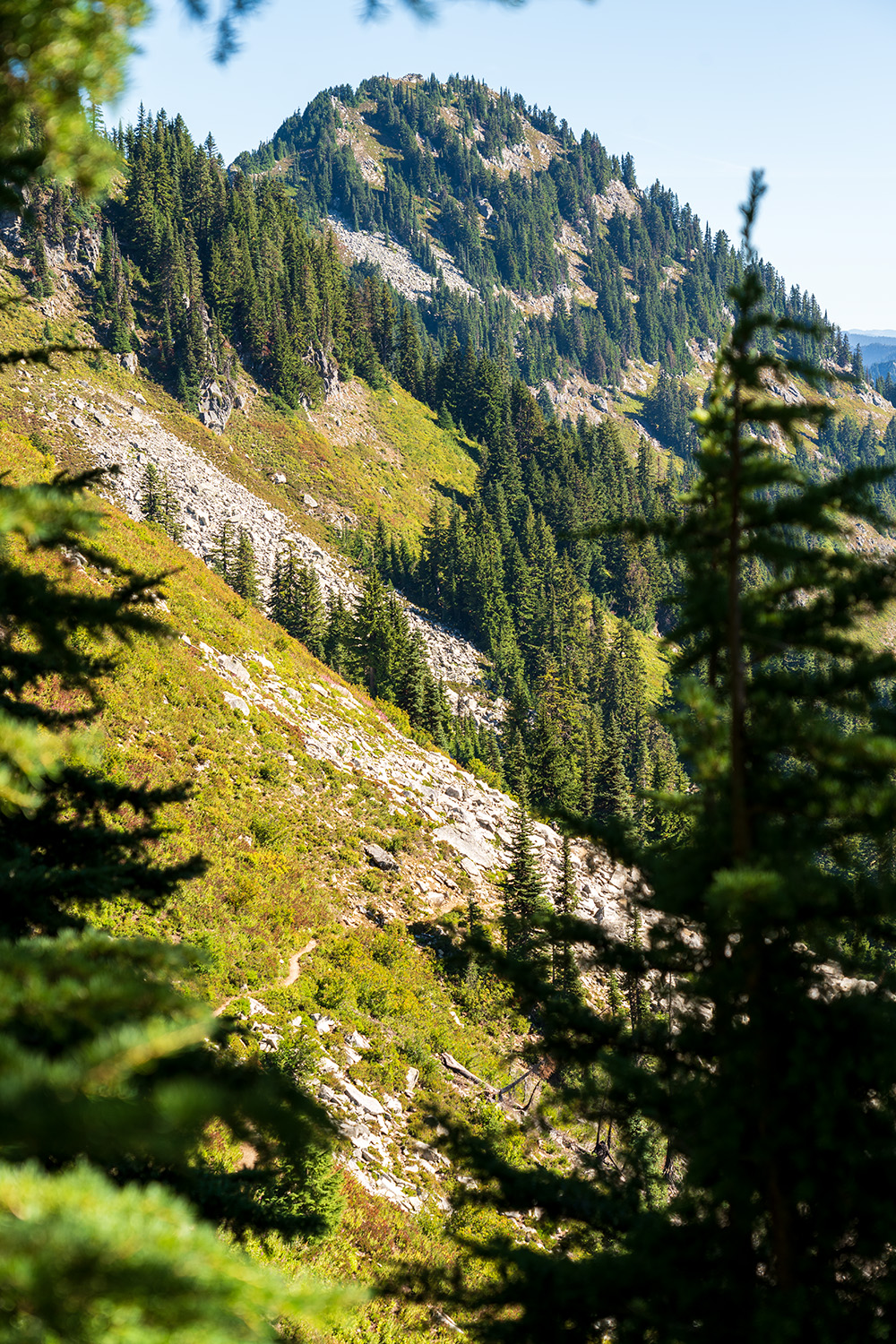



Water Sources Along the Trail
Water is plentiful along the trail, so you shouldn’t have much trouble finding it:
- Small streams: Near the start of the trail.
- Hope Lake: At 1.5 miles.
- Streams: Located at 2.1 miles, 3.3 miles, and 4 miles between Hope Lake and Trap Lake.
- Trap Lake: At 4.6 miles (requires a descent down to the lake).
- Thunder Mountain Lakes: At 6.5 miles
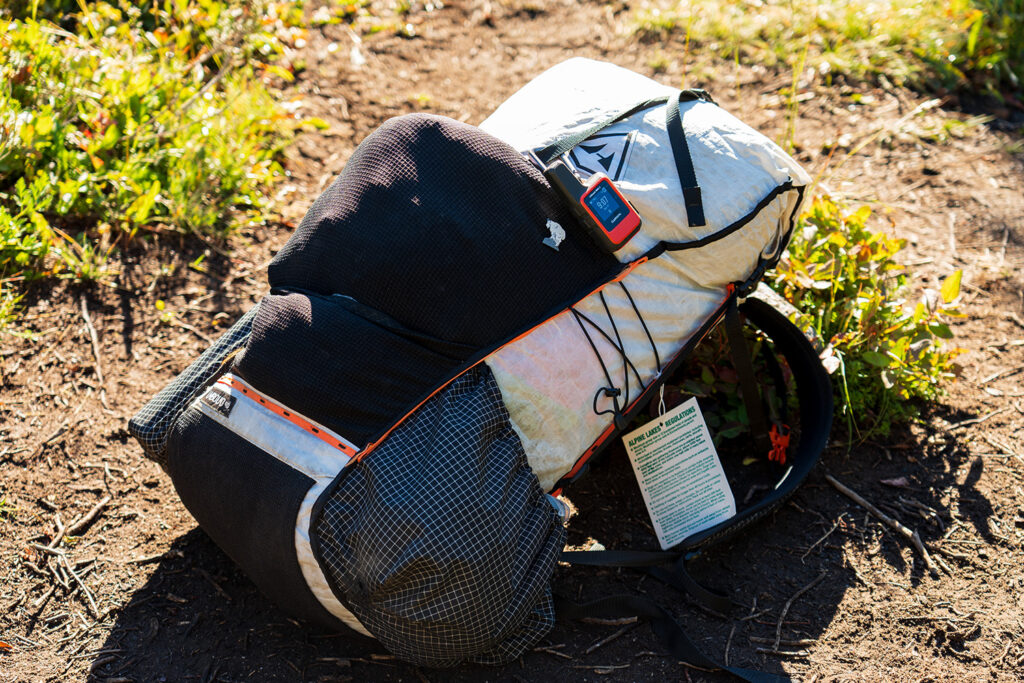
Camping Options Along the Thunder Mountain Lakes Trail
I’ve provided a map with waypoints showing where the campsites are located along the trail so be sure to take a look at that to get a better idea of the available camping options.
Hope Lake Campsites
Located at Hope Lake, these campsites are ideal for hikers seeking a more secluded spot along the trail. The area offers several sites nestled within the forest, with easy access to the lake for water. These campsites are a great option for those arriving late in the day or who prefer a shorter hike before setting up camp. It’s a perfect stopping point if you don’t have enough time to reach Thunder Mountain Lakes before nightfall.

Small Tent Sites Between Hope and Trap Lake
Between Hope Lake and Trap Lake, there are a few small tent sites along the trail. These trailside spots are primarily used by PCT hikers and would serve as last-resort options if you’re in a pinch. While they aren’t the most ideal for an extended stay, it’s useful to know where they are located in case you find yourself needing a place to set up camp unexpectedly.
Trap Lake Campsites
From the main trail, you can descend down to Trap Lake to find additional campsite options. These sites are a great choice if you’re starting late and need a place to stay before continuing to Thunder Mountain Lakes. Most of the campsites are located on the north end of the lake, where a flat, grassy area provides an ideal spot to pitch your tent.
Thunder Mountain Lakes Campsites
There are well-established campsites around Trap Lake, so be sure to use these existing sites and avoid creating new ones. The terrain here is extremely fragile, and any disturbance could take years to recover. The best camping options are the large granite slabs, which not only offer the most stunning views but also help prevent damage to the delicate plant life. Camping on these durable surfaces is the best way to minimize your impact!
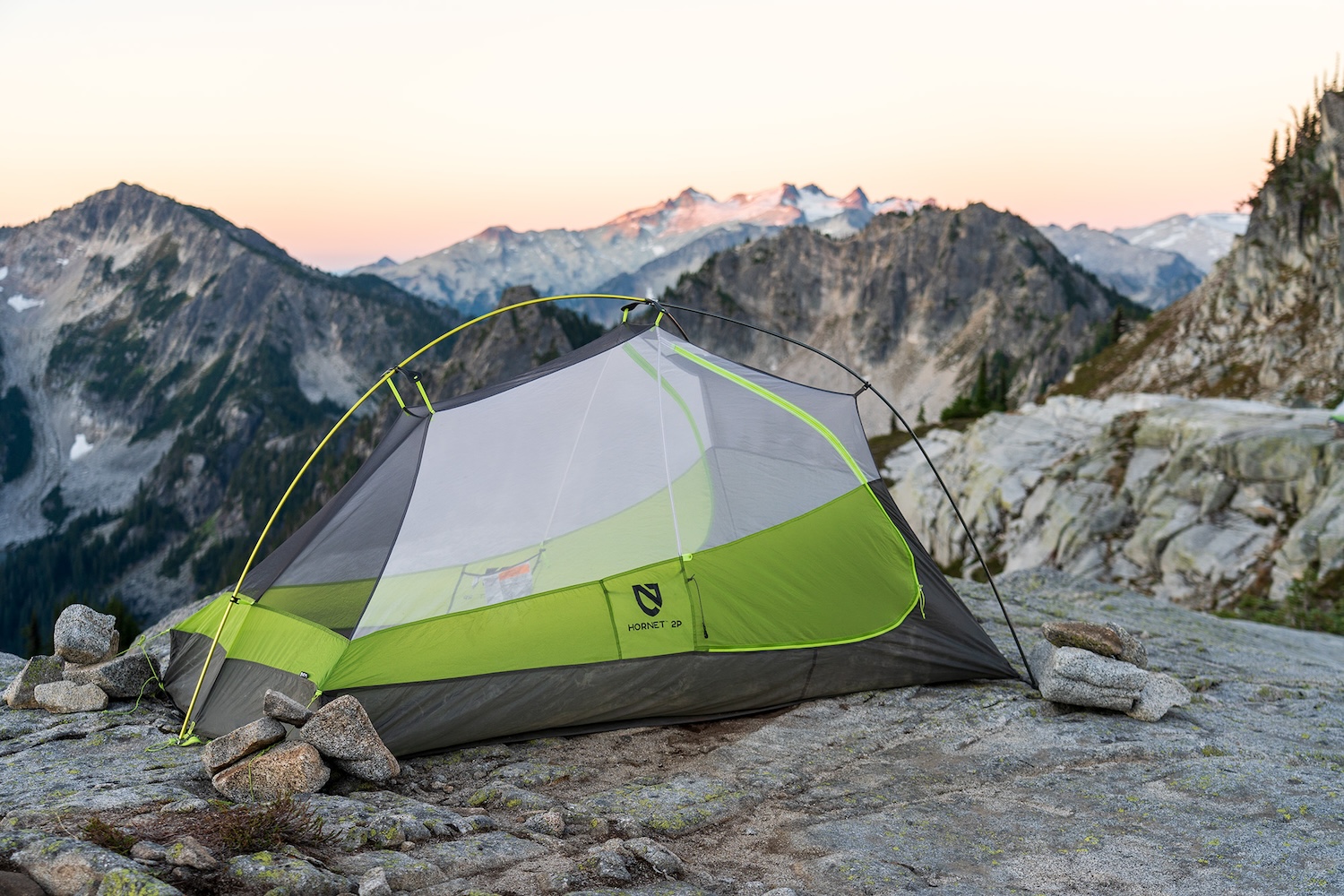
Thunder Mountain Lakes Overlook Campsite
On the trail map, I’ve included the coordinates for an incredible overlook campsite located slightly above Thunder Mountain Lakes. This spot has room for just one tent but offers stunning views of the lake and the surrounding Alpine Lakes Wilderness. While the site isn’t the most convenient—requiring a steep climb to reach—the views are impressive.
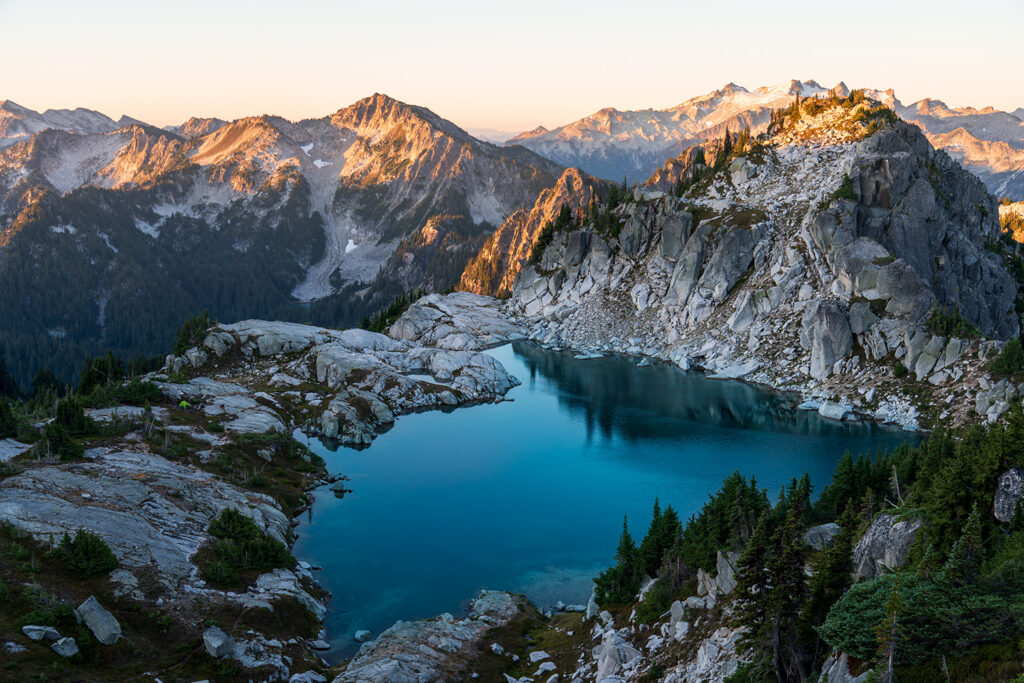
Things to do at Thunder Mountain Lakes
For me, the highlight of this trip was simply spending time at Thunder Mountain Lakes. It’s one of the most beautiful alpine lakes I’ve stayed at, offering a sense of seclusion due to the lack of crowds. The views are incredible, with sweeping vistas of the North Cascade Mountains and the Alpine Lakes Wilderness. Notable peaks include Stuart Peak in the Enchantments and Mount Daniel with its glaciers. A short walk along the lake brings you to a ridge with views of Baring Mountain to the north.
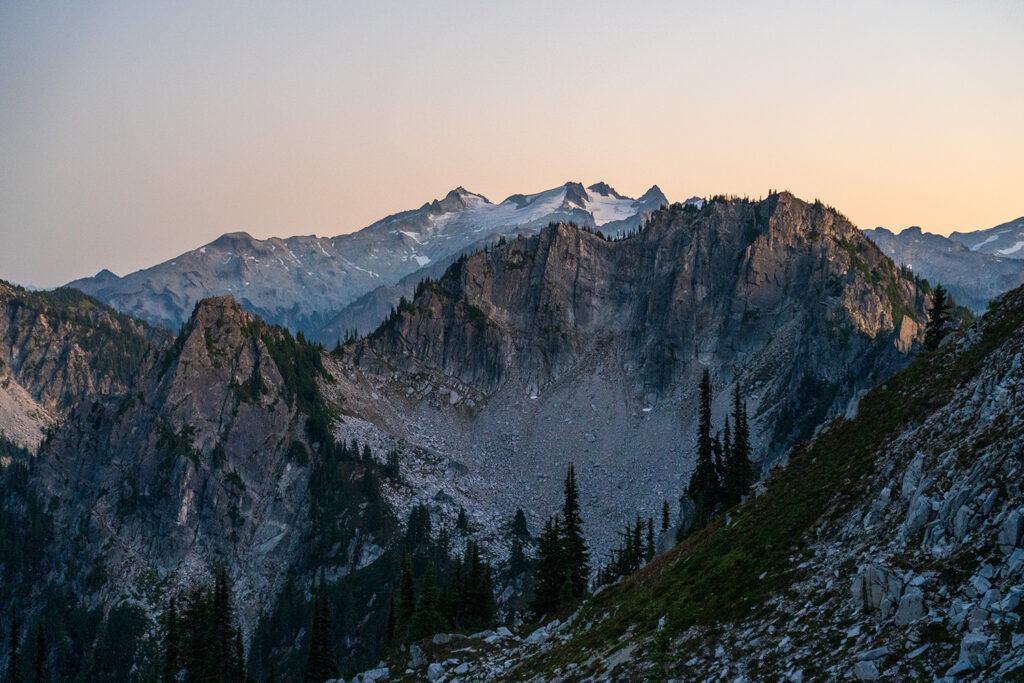
Sunset and sunrise are incredibly beautiful from this location. The soft light during these times creates a stunning atmospheric perspective, layering the mountains and adding depth to the already breathtaking views. This is always my favorite part of the day, and catching sunset on the ridgeline above the lake and sunrise at the summit of Nimbus Mountain are experiences you should definitely plan for while staying here.
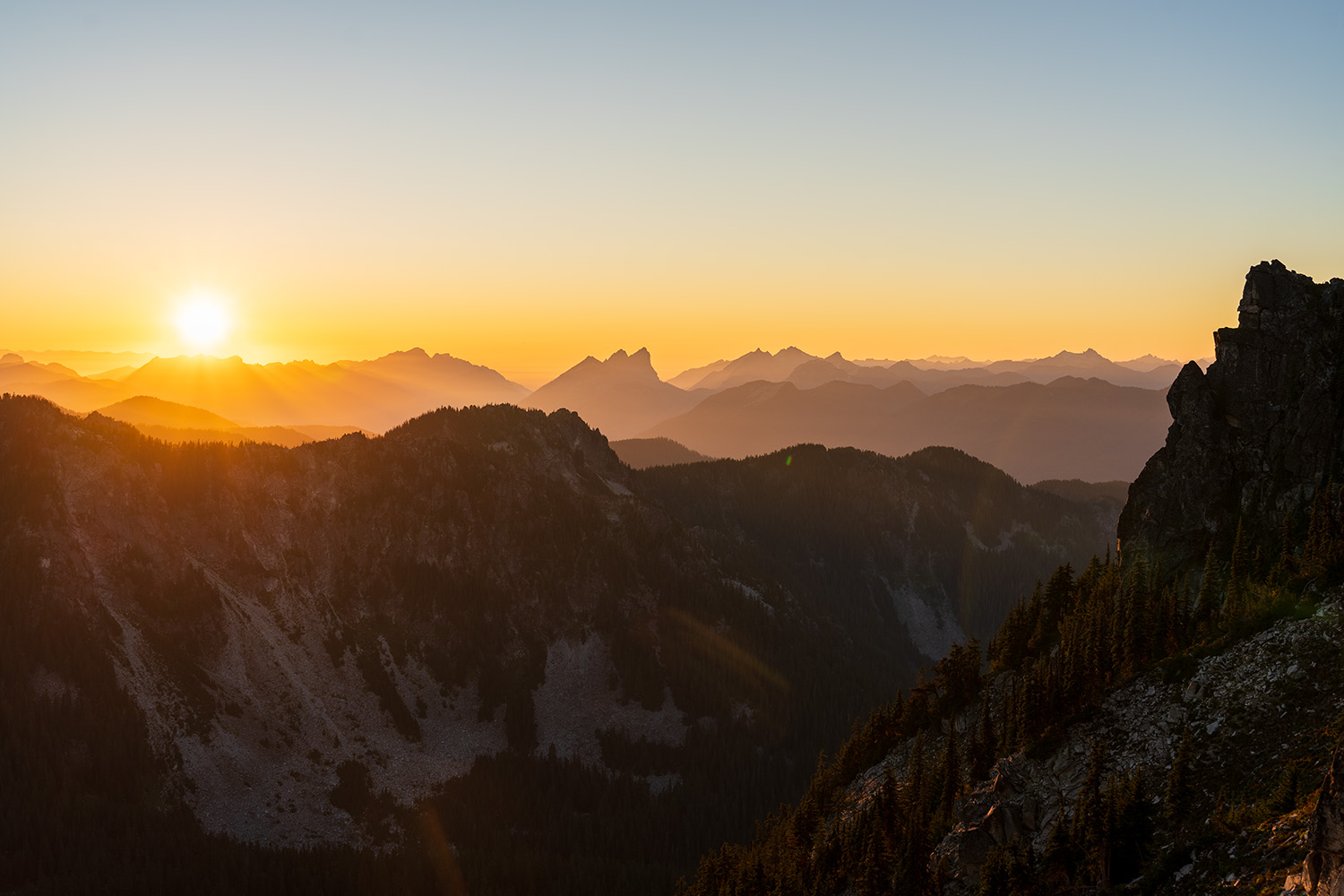
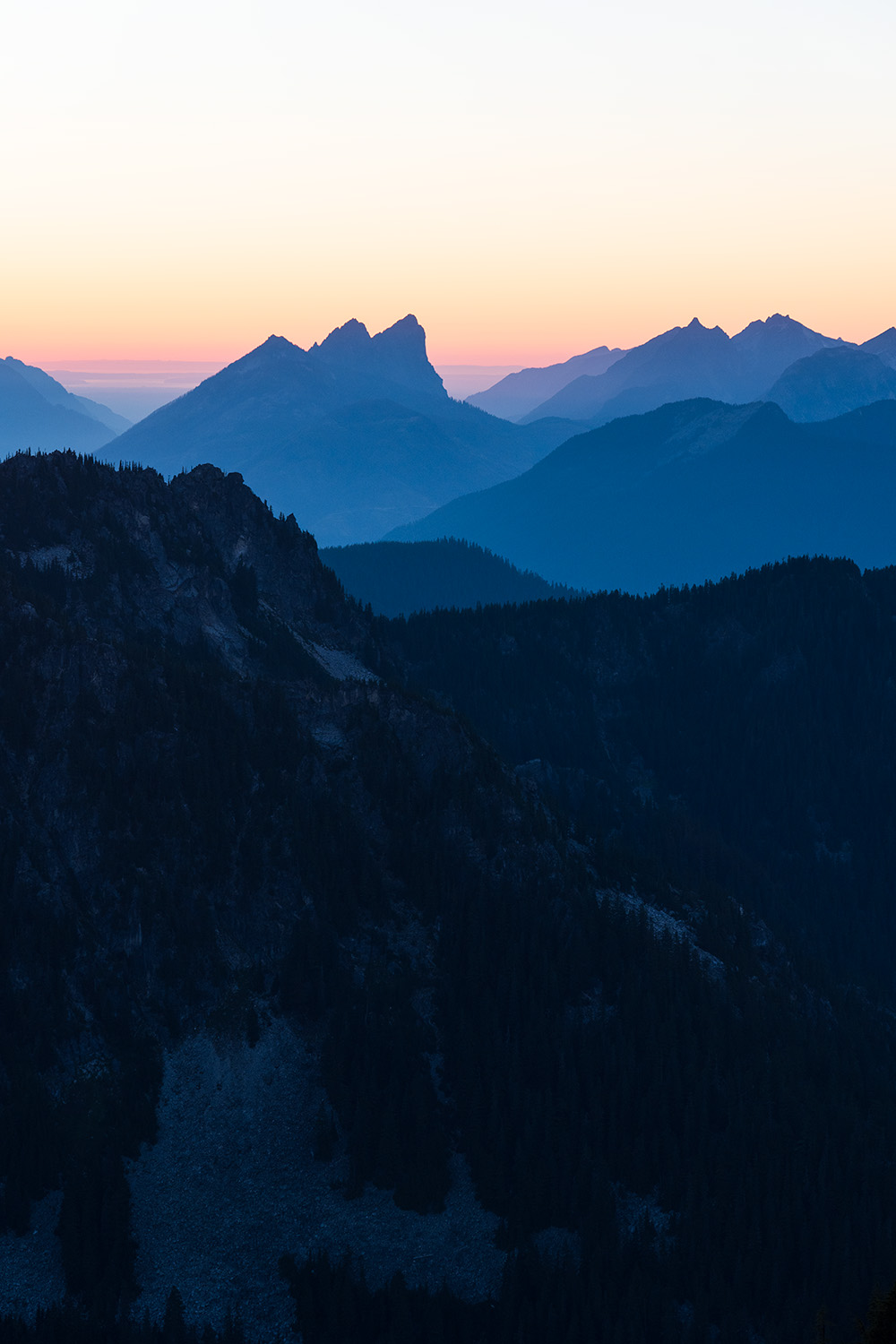
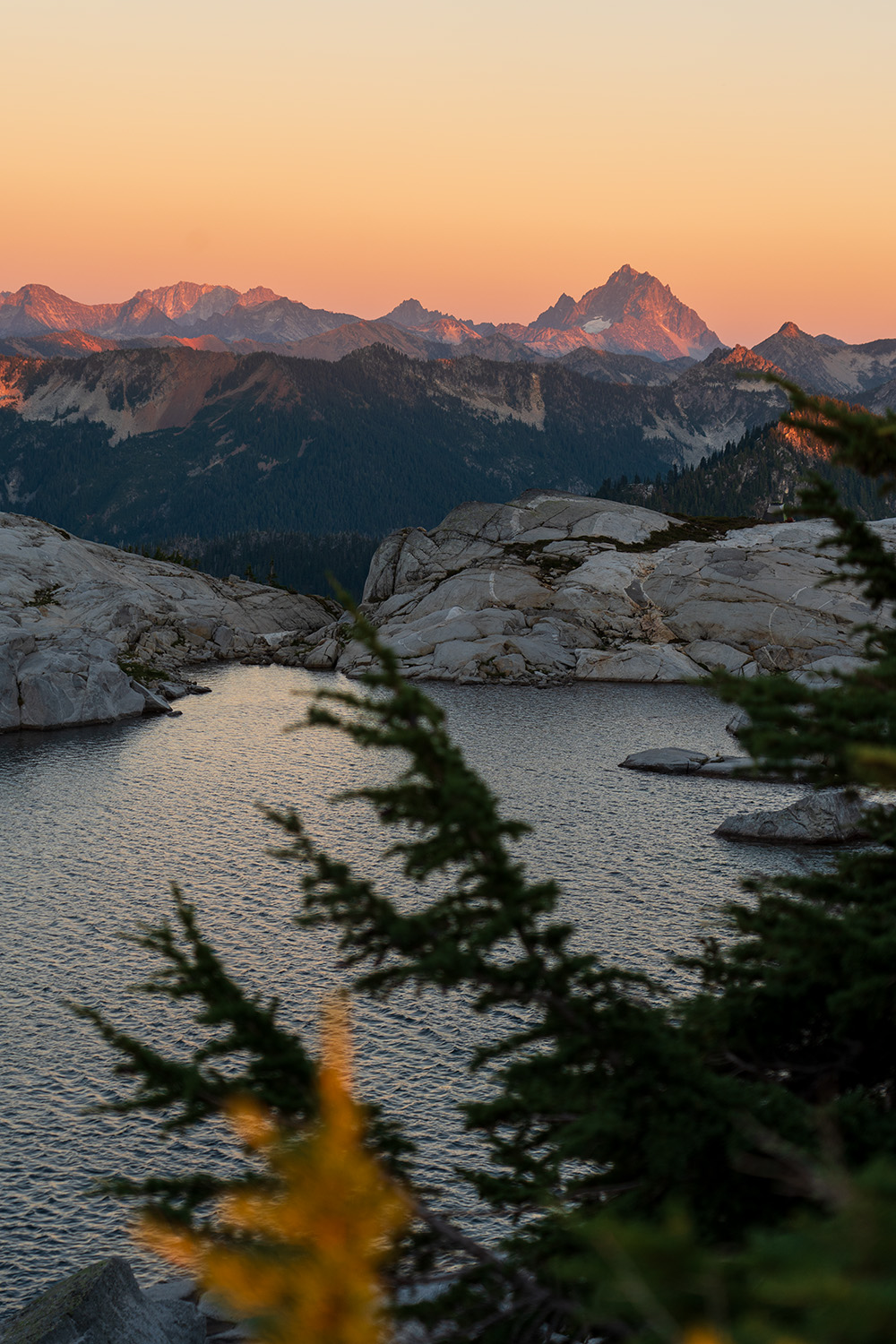
I was lucky enough to see the Aurora Borealis while camping at Thunder Mountain Lakes. I awoke to beams of light dancing across the sky, and when I photographed them, they revealed beautiful shades of green and purple, painting the night with an ethereal glow.
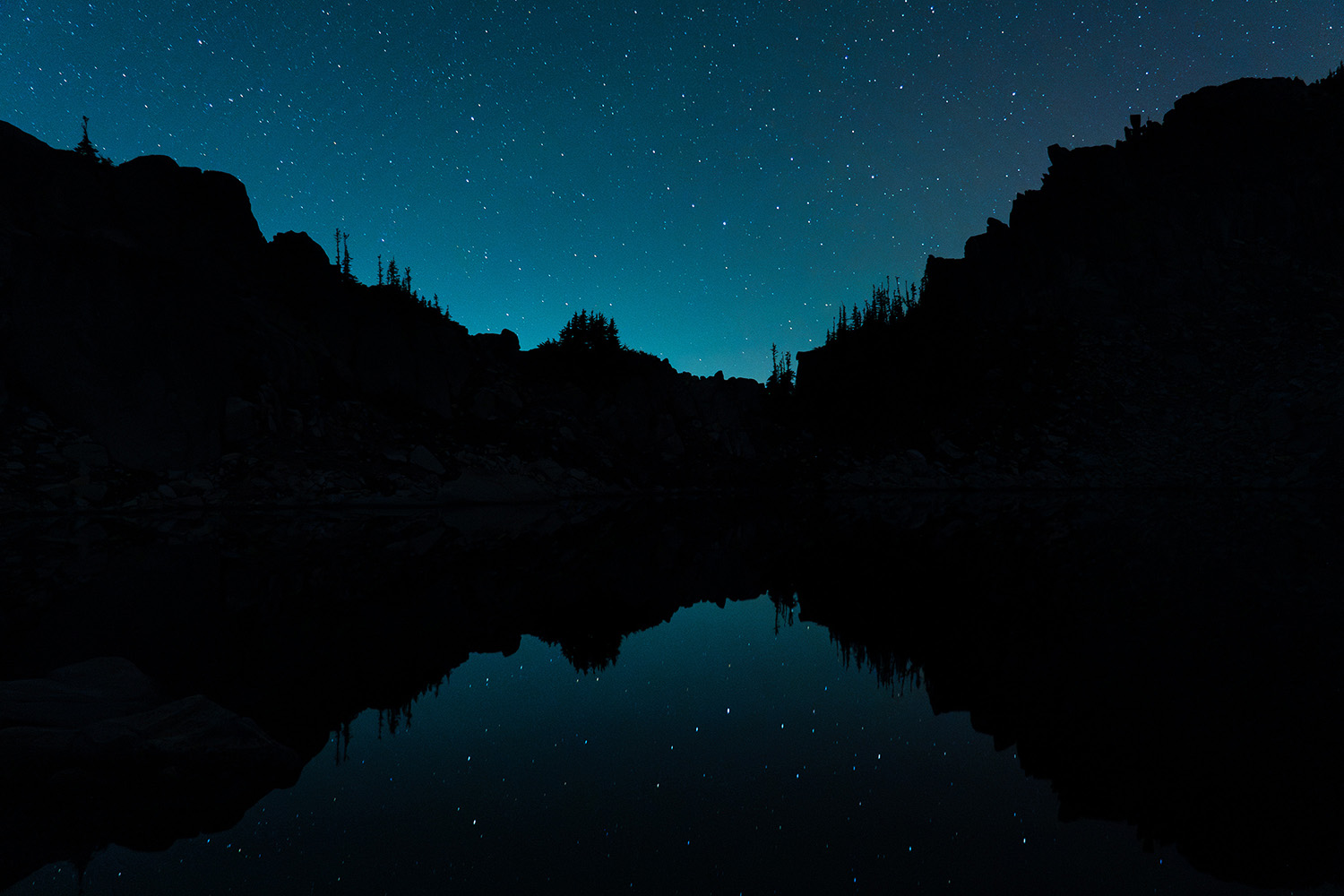

Staying at an alpine lake means a mandatory cold plunge! With temperatures in the 80s and sunny skies during the summer months, taking a dip in the cold lake is incredibly refreshing. I even took my inflatable sleeping pad out on the lake to float around—it was the perfect way to relax and cool off after the hike.
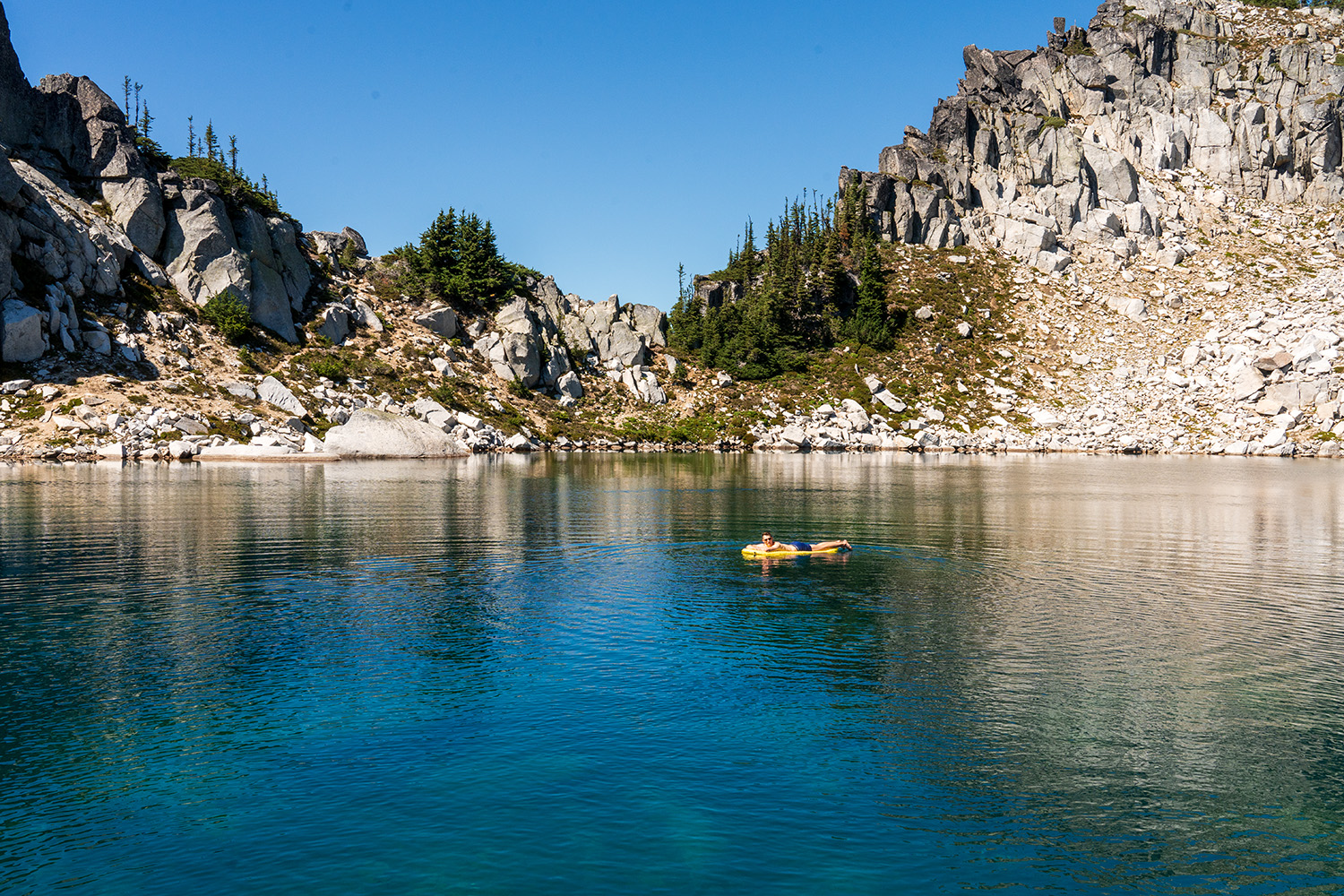
Thunder Mountain Lakes consists of two lakes: Upper and Lower Thunder Lakes. The Upper Lake is the main attraction, where most people choose to camp due to its superior views. However, if you have extra time, exploring the Lower Lake can be a nice way to spend the day. With no other trails connecting to this area, exploration is limited to the surrounding terrain unless you venture further. The terrain is very fragile, so be sure to stay on designated trails and avoid creating new ones. The views from the summit of Nimbus Mountain are also worth the effort.
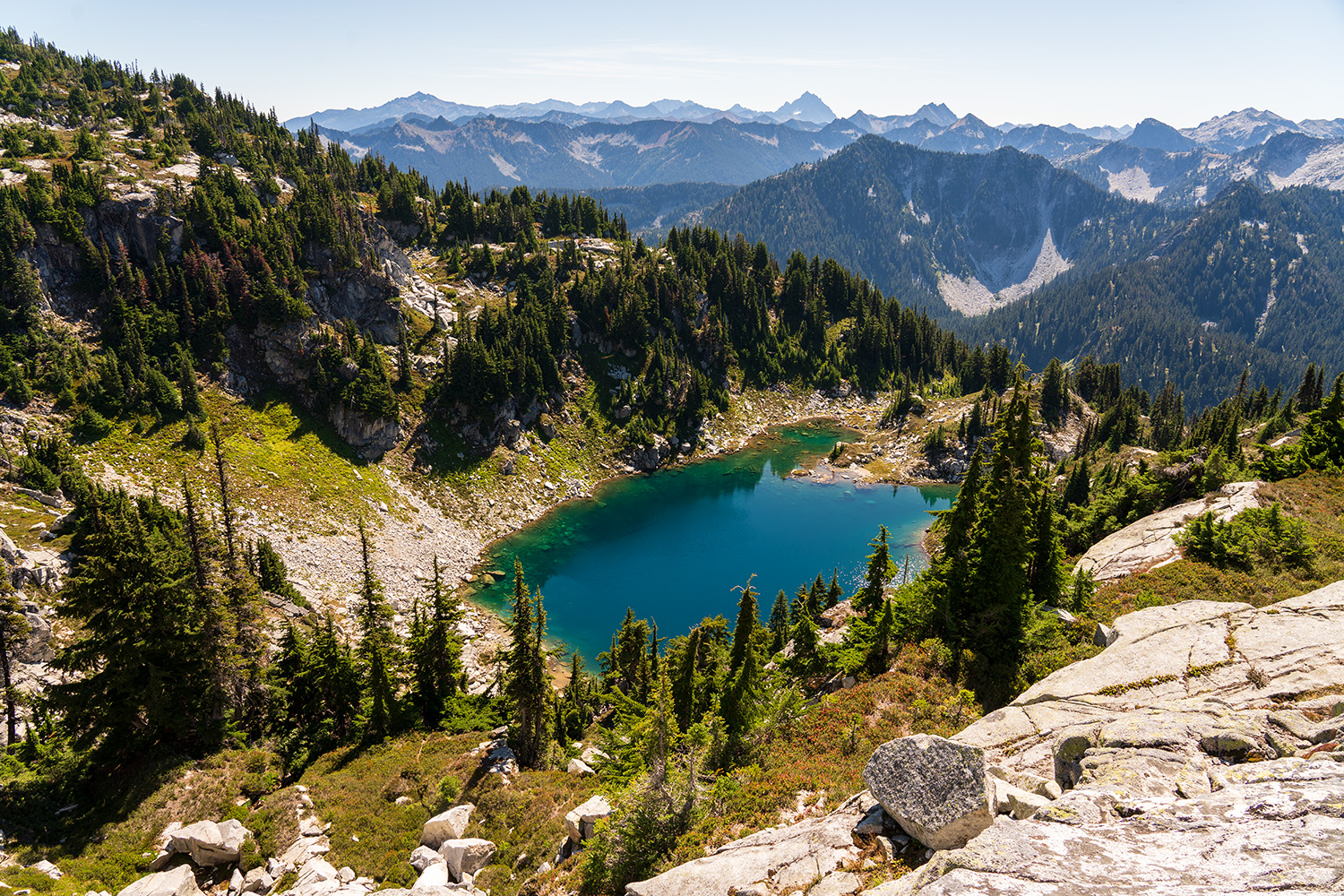
Alpine Lakes Regulations (Specific to Thunder Mountain Lakes)
- Maximum group size: 12 people
- No motorized/mechanized equipment (e.g., bikes, drones)
- Campfires/gathering firewood prohibited above 5,000 feet and within 1/2 mile near lakes
- Camp on durable surfaces
- Leash dogs
- Stay on trails; don’t cut switchbacks
- No supply caching over 48 hours
- Bury waste away from camps/water sources. Pack out all litter.
Will I have cell service on the trail?
Throughout most of the hike, you won’t have cell service. However, I was able to get some coverage from the summit of Nimbus Mountain, which overlooks Thunder Mountain Lakes, and on the ridge above the west side of the lake. For safety, I always carry my Garmin InReach Mini for emergency situations when cell phone coverage isn’t available.
Are there Mountain Goats?
This area is known for mountain goat activity, so you might get lucky and spot some. I noticed goat fur in some pine thickets and saw the numerous paths they’ve created. One crucial tip: always urinate on rocks, not plants. Mountain goats crave the salt in urine and will destroy fragile vegetation to get it. Keeping to rocks helps protect the delicate alpine environment.

Thunder Mountain Lakes – A Worthy Alpine Lake Experience
Thunder Mountain Lakes offers an exceptional hiking experience that stands out from the more crowded trails in the Alpine Lakes Wilderness. My time here was unforgettable, from the serene beauty and relaxation at the lake to the breathtaking sunsets and the rare sight of the Aurora Borealis. If you’re looking to escape the crowds and truly connect with the wilderness, Thunder Mountain Lakes should be at the top of your list. This trail provides a perfect blend of adventure, tranquility, and natural beauty.



